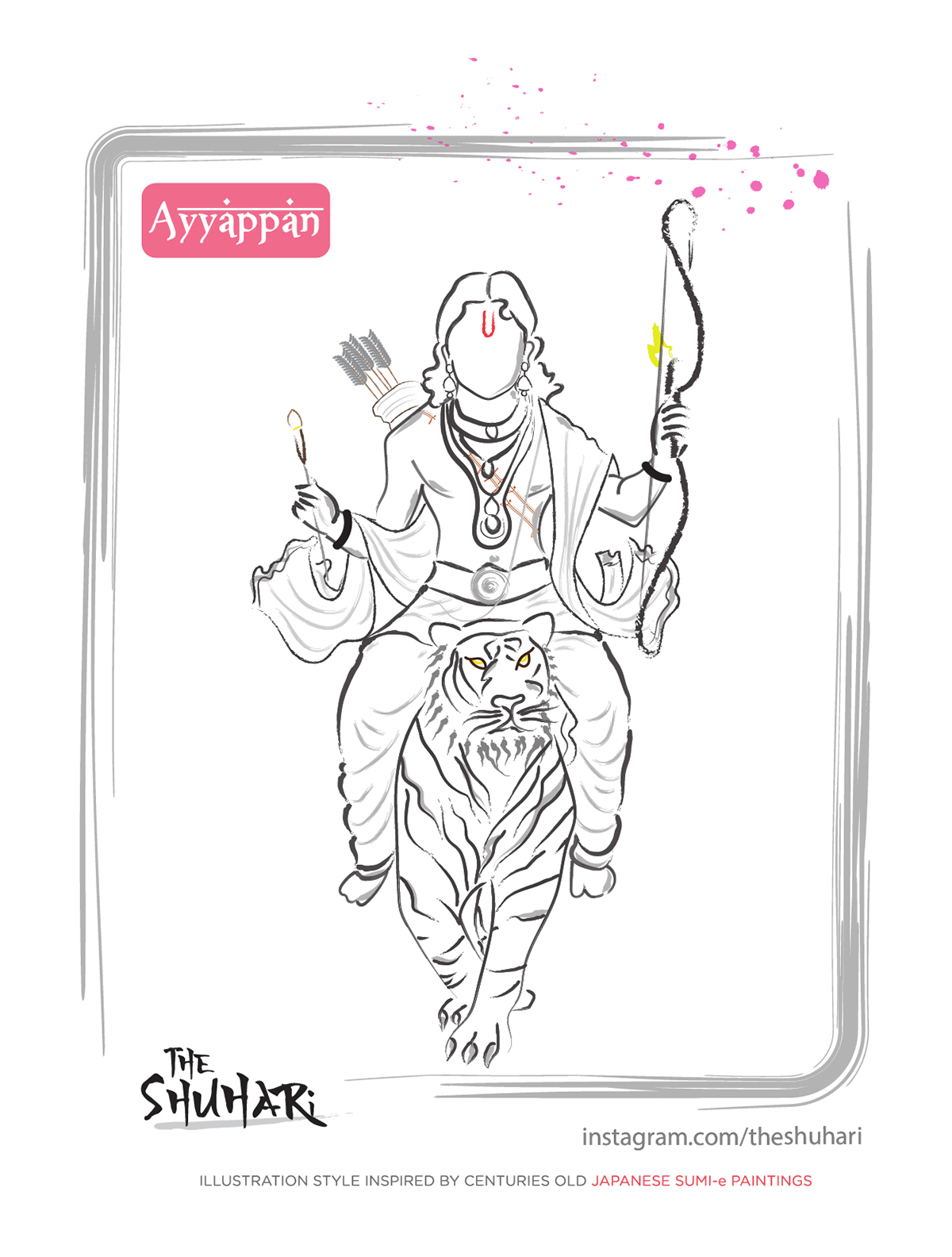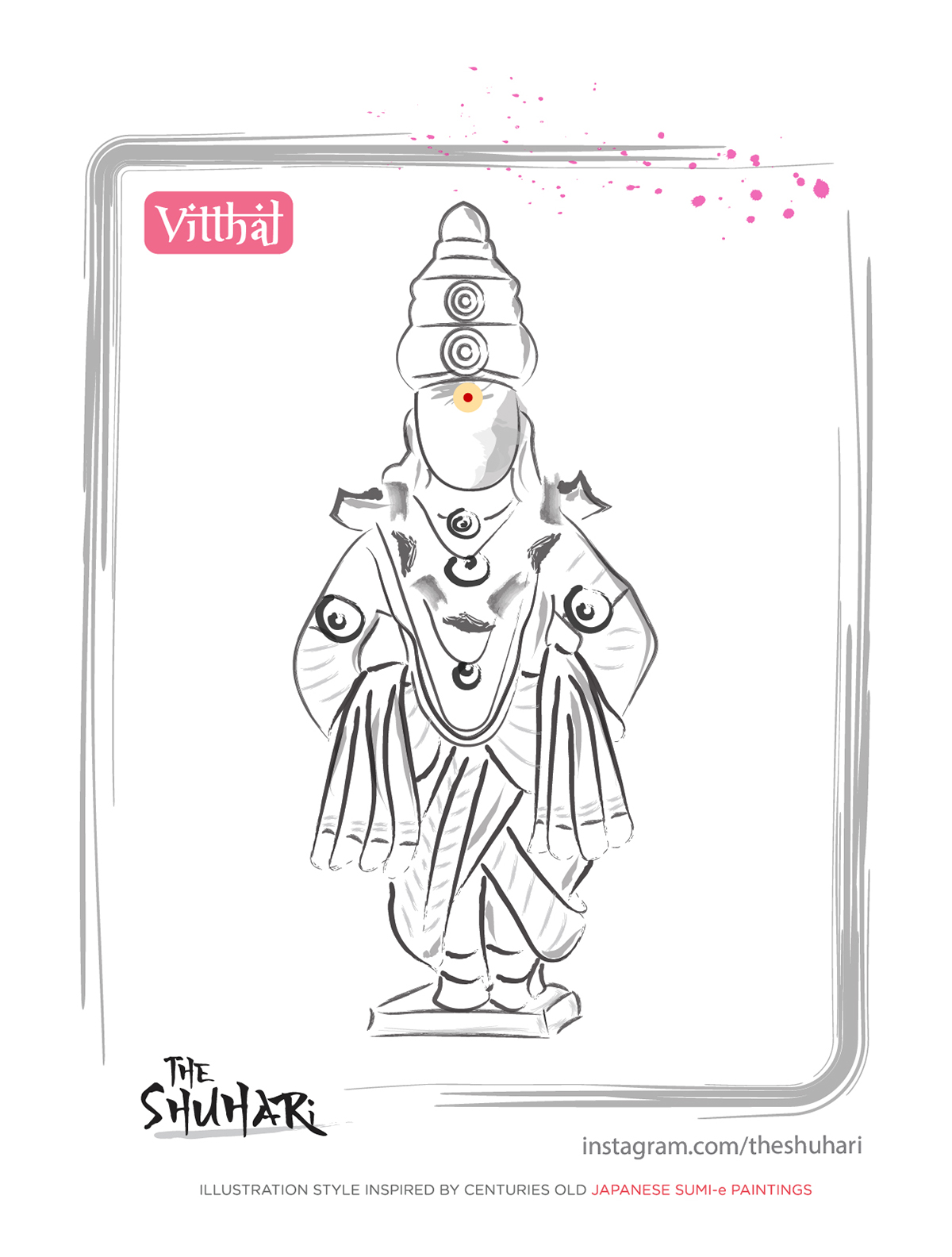We Indian’s have a very strong belief in God. Before starting any important work, we pray to God for the success of the work. Likewise I have started my designing career by making God illustrations in Sumi-E style.
Sumi-E is the Japanese name for ink wash painting, also known as literati painting which is an East Asian type of brush painting.
Every God illustration in India cannot be scribbled in the way we want. Chitrasutra was developed by lord Vishnu which describes the anatomy of Gods. I just reflected the same in Sumi-E style. These illustrations are first of its own kind.
All the illustrations are available for sale. These are done in Vector, editable and scalable to 1000%.

Ayyappan is the Hindu god of growth, particularly popular in Kerala. He is a synthetic deity, the son of Shiva and Mohini. Ayyappan is also referred to as Ayyappa, Sartavu, Hariharaputra, Manikanta, Shasta or Dharma Shasta. The most prominent Ayyappan shrine is at Sabarimala, nestled in the hills of Pathanamthitta of Kerala. -Wikipedia.

Brahma (Sanskrit: ब्रह्मा) is a creator god in Hinduism. He has four faces. Brahma is also known as Svayambhu (self-born),Vāgīśa (Lord of Speech), and the creator of the four Vedas. Brahma is part of the "Brahma, Vishnu, Shiva" in Trimurti. Several puranas describe him emerging from a lotus, connected to the navel of Lord Vishnu. -Wikipedia.

Gautama Buddha, also known as Siddhārtha Gautama or simply the Buddha, was an ascetic and sage, on whose teachings Buddhism was founded. Gautama is the primary figure in Buddhism. He is recognized by Buddhists as an enlightened teacher who attained full Buddhahood, and shared his insights to help sentient beings end rebirth and suffering. -Wikipedia.

Goddess Gauri is Devi, Shakti or the Mother Goddess, who appears in many forms, such as Durga, Parvati, Kali and others. She is auspicious, brilliant and protects the good people while punishing those who perform evil deeds. Mother Gauri enlightens the spiritual seeker and removes the fear of rebirth by granting salvation. She is the incarnation of Goddess Shakti and/or Parvati (Durga). -Wikipedia.

Hanuman is an ardent devotee of Lord Rama. He is also depicted as an incarnation of Shiva. Hanuman is the son of Anjana and Kesari and is also son of the wind-god Vayu. He is considered to be an exemplification of strength, devotion, and perseverance. -Wikipedia.

Kāli, also known as Kālikā (Sanskrit: कालिका), is a Hindu goddess. Kali's earliest appearance is that of a destroyer of evil forces. She is been worshipped by devotional movements and tantric sects variously as the Divine Mother, Mother of the Universe, Adi Shakti, or Adi Parashakti. She is also seen as divine protector and the one who bestows moksha, or liberation. Kali is one of the ten Mahavidyas. -Wikipedia.

Krishna is worshiped as the eighth avatar of God Vishnu and also as the supreme God in his own right. He is the god of compassion, tenderness, and love in Hinduism and is one of the most popular and widely revered among Indian divinities. The anecdotes and narratives of Krishna's life are generally titled as Krishna Leela. -Wikipedia.

Kubera, also known as Kuvera or Kuber, is the Lord of Wealth and the god-king of the semi-divine Yakshas in Hindu mythology. He is regarded as the regent of the North (Dik-pala), and a protector of the world (Lokapala). His many epithets extol him as the owner of the treasures of the world. Kubera is often depicted with a plump body, adorned with jewels, and carrying a money-pot and a club. -Wikipedia.

Lakshmi is the Hindu goddess of wealth, fortune and prosperity. She is the wife and shakti (energy) of Vishnu. Lakshmi is also the goddess of abundance and fortune. -Wikipedia.

Mohini (Sanskrit: मोहिनी) is the only female avatar of the Hindu god Vishnu. She is portrayed as an enchantress, who maddens lovers, sometimes leading them to their doom. Mohini is introduced into the Hindu Belief system in the narrative epic of the Mahabharata. Here, she appears as a form of Vishnu, acquires the pot of Amrita (an elixir of immortality) from thieving asuras (demons), and gives it back to the devas (gods), helping them retain their immortality. -Wikipedia.

Kartikeya is the Hindu god of war. He is the son of Parvati and Shiva and brother of Ganesha. Kartikeya is an ancient god, traceable to the Vedic era. He is found in many medieval temples all over India, such as at the Ellora Caves and Elephanta Caves. He is typically represented as an ever-youthful man, riding or near a peacock, dressed with weapons sometimes near a rooster. -Wikipedia.

Nandi is depicted as a bull, who serves as the mount (Vahana) and gana of Lord Shiva and is a gate-guardian deity of Kailashagiri. According to Shaiva tradition, he is considered as the chief guru of eight disciples of Nandinatha Sampradaya. The white color of the bull symbolizes purity and justice. -Wikipedia.

Narasimha, is an avatar of the Hindu god Vishnu, one who incarnates in the form of part lion and part man to destroy an evil, end religious persecution and calamity on earth, thereby restoring Dharma. Narasimha is known primarily as the 'Great Protector' who specifically defends and protects his devotees from evil. -Wikipedia.

Ram (Sanskrit: राम) also known as Ramachandra, is a major deity of Hinduism. He is the seventh avatar of the god Vishnu. He is considered the Supreme Being. Rama was born to Kaushalya and Dasharatha in Ayodhya, the ruler of the Kingdom of Kosala. His siblings included Lakshmana, Bharata, and Shatrughna. Rama is especially important to Vaishnavism. He is the central figure of the ancient Hindu epic Ramayana. -Wikipedia.

Saraswati is the Hindu goddess of knowledge, music, arts, wisdom, and learning worshipped throughout Nepal and India. She is a part of the trinity (Tridevi) of Saraswati, Lakshmi and Parvati. -Wikipedia.

Vishnu is one of the principal deities of Hinduism, and the Supreme Being in its Vaishnavism tradition. Vishnu is the "preserver" in the Hindu trinity (Trimurti) that includes Brahma and Shiva. Vishnu is usually depicted as having a dark, or pale blue complexion and having four arms. He holds a padma (lotus flower), Kaumodaki gada (mace), Panchajanya shankha (conch) and the Sudarshana Chakra (discus). -Wikipedia.

Vithoba, also known as Vitthal and Panduranga, is a Hindu god predominantly worshipped in the Indian states of Maharashtra, Karnataka, Goa, Telangana and Andhra Pradesh. He is generally considered a manifestation of the god Vishnu or his avatar, Krishna. Vithoba is often depicted as a dark young boy, standing arms akimbo on a brick, sometimes accompanied by his main consort Rakhumai. Vitthal Temple, Pandharpur is his main temple. -Wikipedia.







